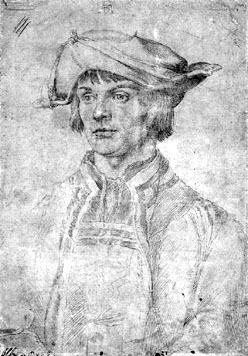| Lucas van Leyden  Born: 1489 Born: 1489
Birthplace: Leiden, Netherlands
Died: 8-Aug-1533
Location of death: Leiden, Netherlands
Cause of death: unspecified
Gender: Male
Race or Ethnicity: White
Occupation: Engraver, Painter Nationality: Netherlands
Executive summary: Dutch Renaissance engraver, painter Dutch painter and engraver, born at Leiden, where his father Huig Jacobsz gave him the first lessons in art. He then entered the painting-room of Cornelis Engelbrechtszen of Leiden, and soon became known for his capacity in making designs for glass, engraving copperplates, painting pictures, portraits and landscapes in oil and distemper. According to van Mander he was born in 1494, and painted at the age of twelve a "Legend of St. Hubert" for which he was paid a dozen florins. He was only fourteen when he finished a plate representing Mahomet taking the life of Sergius, the monk, and at fifteen he produced a series of nine plates for a "Passion", a "Temptation of St. Anthony", and a "Conversion of St. Paul." The list of his engravings in 1510, when, according to van Mander, he was only sixteen, includes subjects as various as a celebrated "Ecce Homo", "Adam and Eve expelled from Paradise", a herdsman and a milkmaid with three cows, and a little naked girl running away from a barking dog. Whatever may be thought of the tradition embodied in van Mander's pages as to the true age of Lucas van Leyden, there is no doubt that, as early as 1508, he was a master of repute as a copperplate engraver. It was the time when art found patrons among the public that could ill afford to buy pictures, yet had enough interest in culture to satisfy itself by means of prints. Lucas van Leyden became the representative man for the public of Holland as Albrecht Dürer for that of Germany; and a rivalry grew up between the two engravers, which came to be so close that on the neutral market of Italy the products of each were all but evenly quoted. Giorgio Vasari affirmed that Dürer surpassed Lucas as a designer, but that in the use of the graver they were both unsurpassed, a judgment which has not been reversed. But the rivalry was friendly. About the time when Dürer visited the Netherlands Lucas went to Antwerp, which then flourished as an international mart for productions of the pencil and the graver, and it is thought that he was the master who took the freedom of the Antwerp guild in 1521 under the name of Lucas the Hollander. In Dürer's diary kept during his travels in the Low Countries, we find that at Antwerp he met Lucas, who asked him to dinner, and that Dürer accepted. He valued the art of Lucas at its true figure, and exchanged the Dutchman's prints for eight florins' worth of his own. In 1527 Lucas made a tour of the Netherlands, giving dinners to the painters of the guilds of Middleburg, Ghent, Malines and Antwerp. He was accompanied during the trip by Jan Mabuse, whom he imitated in his style as well as in his love of rich costume. On his return home he fell sick and remained ailing until his death in 1533, and he believed that poison had been administered to him by some envious comrade.
A few days before his death Lucas van Leyden was informed of the birth of a grandson, first-born of his only daughter Gretchen. Gretchen's fourth son Jean de Hoey followed the profession of his grandfather, and became well known at the Parisian court as painter and chamberlain to the king of France, Henri IV.
As an engraver Lucas van Leyden deserves his reputation. He has not the genius, nor had he the artistic tact, of Dürer; and he displays more cleverness of expression than skill in distribution or in refinement in details. But his power in handling the graver is great, and some his portraits, especially his own, are equal to anything by the master of Nuremberg. Much that he accomplished as a painter has been lost, because he worked a good deal upon cloth in distemper. In 1522 he painted the "Virgin and Child with the Magdalen and a Kneeling Donor", now in the gallery of Munich. His manner was then akin to that of Mabuse. The "Last Judgment" in the town gallery of Leiden is composed on the traditional lines of Cristus and Memling, with monsters in the style of Hieronymus Bosch and figures in the stilted attitudes of the South German school; the scale of colors in yellow, white and grey is at once pale and gaudy, the quaintest contrasts are produced by the juxtaposition of alabaster flesh in females and bronzed skin in males, or black hair by the side of yellow, or rose-colored drapery set sharply against apple-green or black; yet some of the heads are painted with great delicacy and modelled with exquisite feeling. Dr. Waagen gave a favorable opinion of a triptych now at the Hermitage at St. Petersburg, executed, according to van Mander, in 1531, representing the "Blind Man of Jericho healed by Jesus Christ." Here too the German critic observed the union of faulty composition with great finish and warm flesh tints with a gaudy scale of colors. The same defects and qualities will be found in such specimens as are preserved in public collections, among which may be mentioned the "Card Party" at Wilton House, the "Penitent St. Jerome" in the gallery of Berlin, and the hermits "Paul" and "Anthony" in the Liechtenstein collection at Vienna. There is a characteristic "Adoration of the Magi" at Buckingham Palace.
Father: Huig Jacobsz
Do you know something we don't?
Submit a correction or make a comment about this profile
Copyright ©2019 Soylent Communications
|